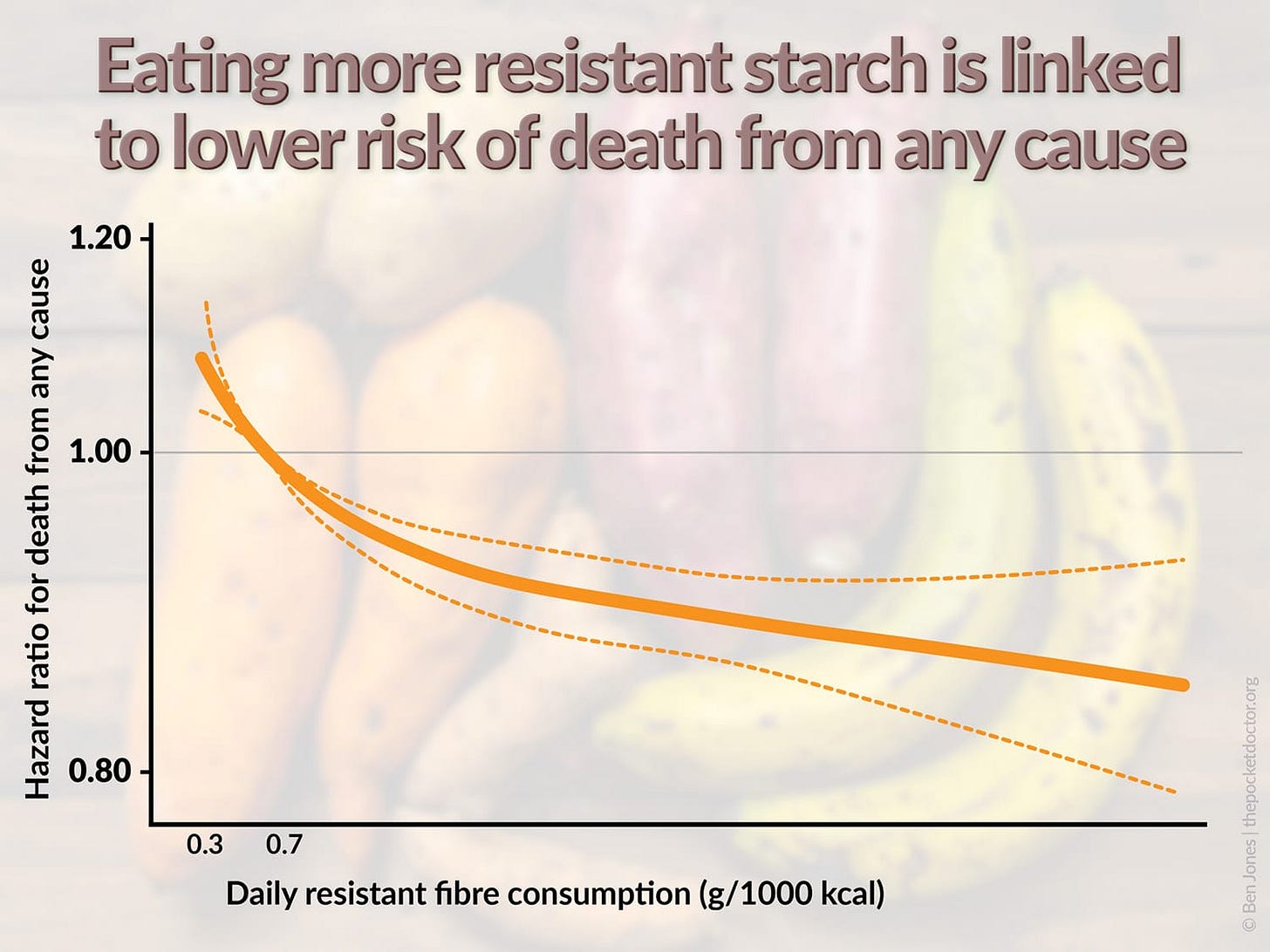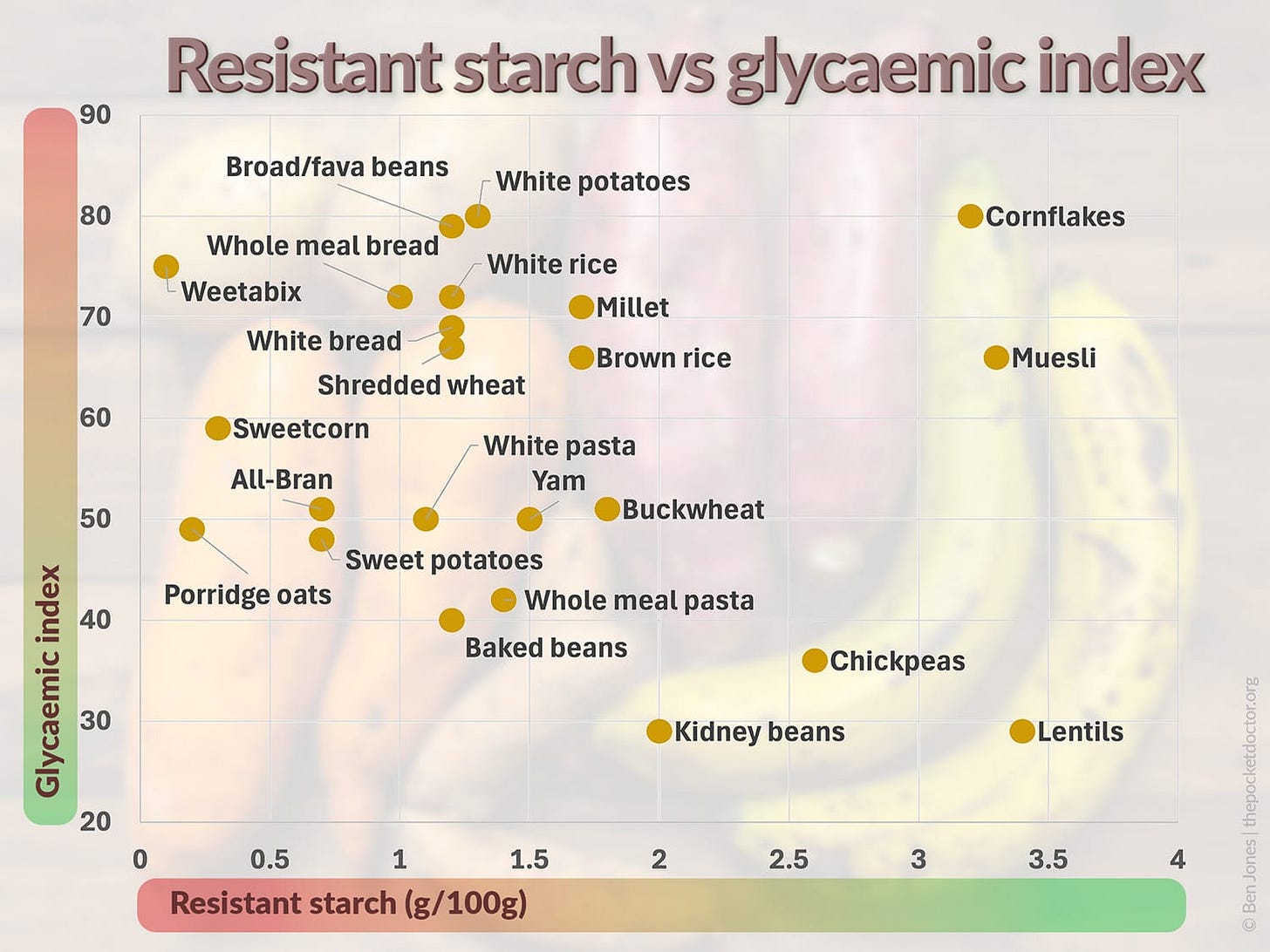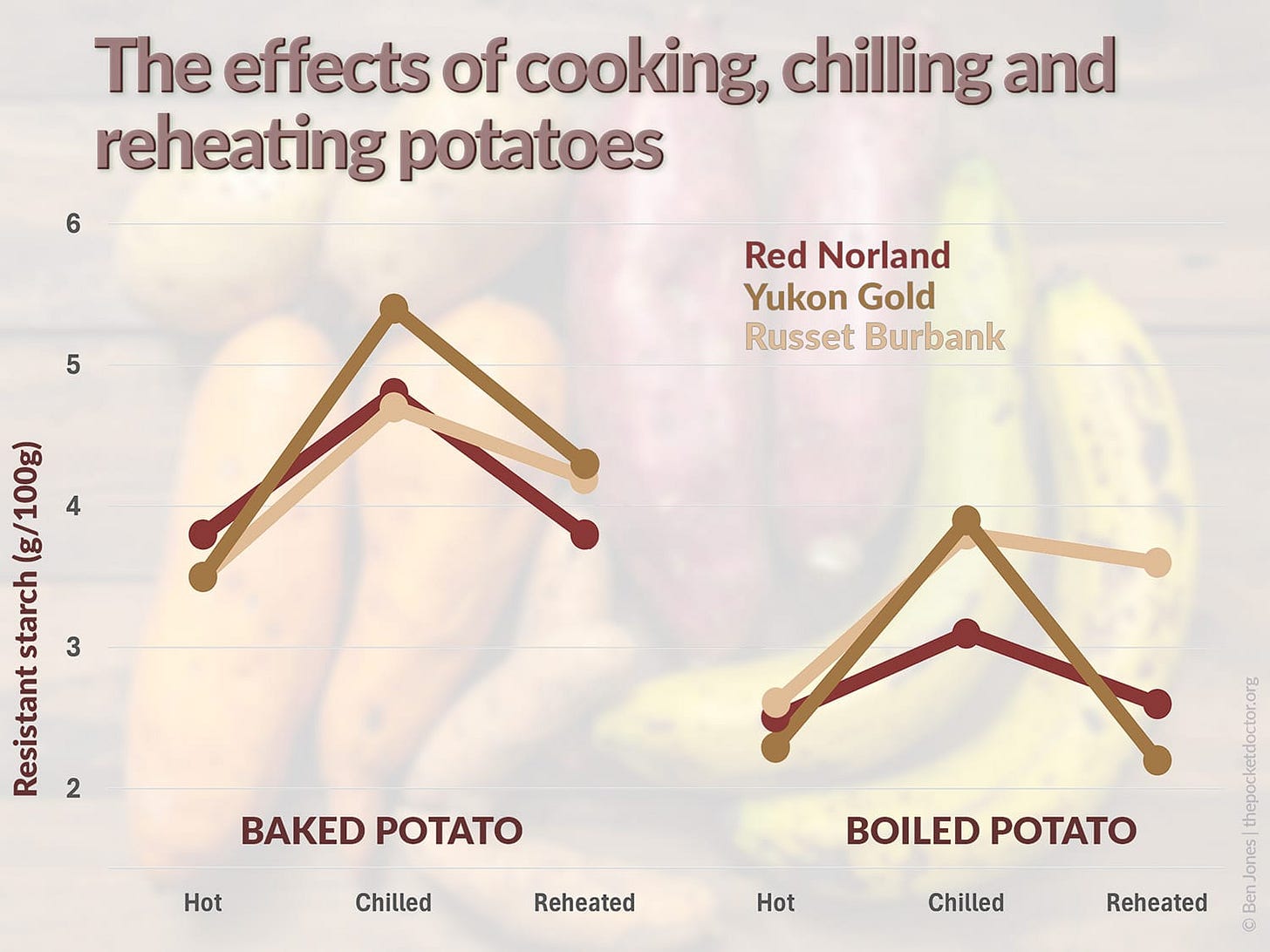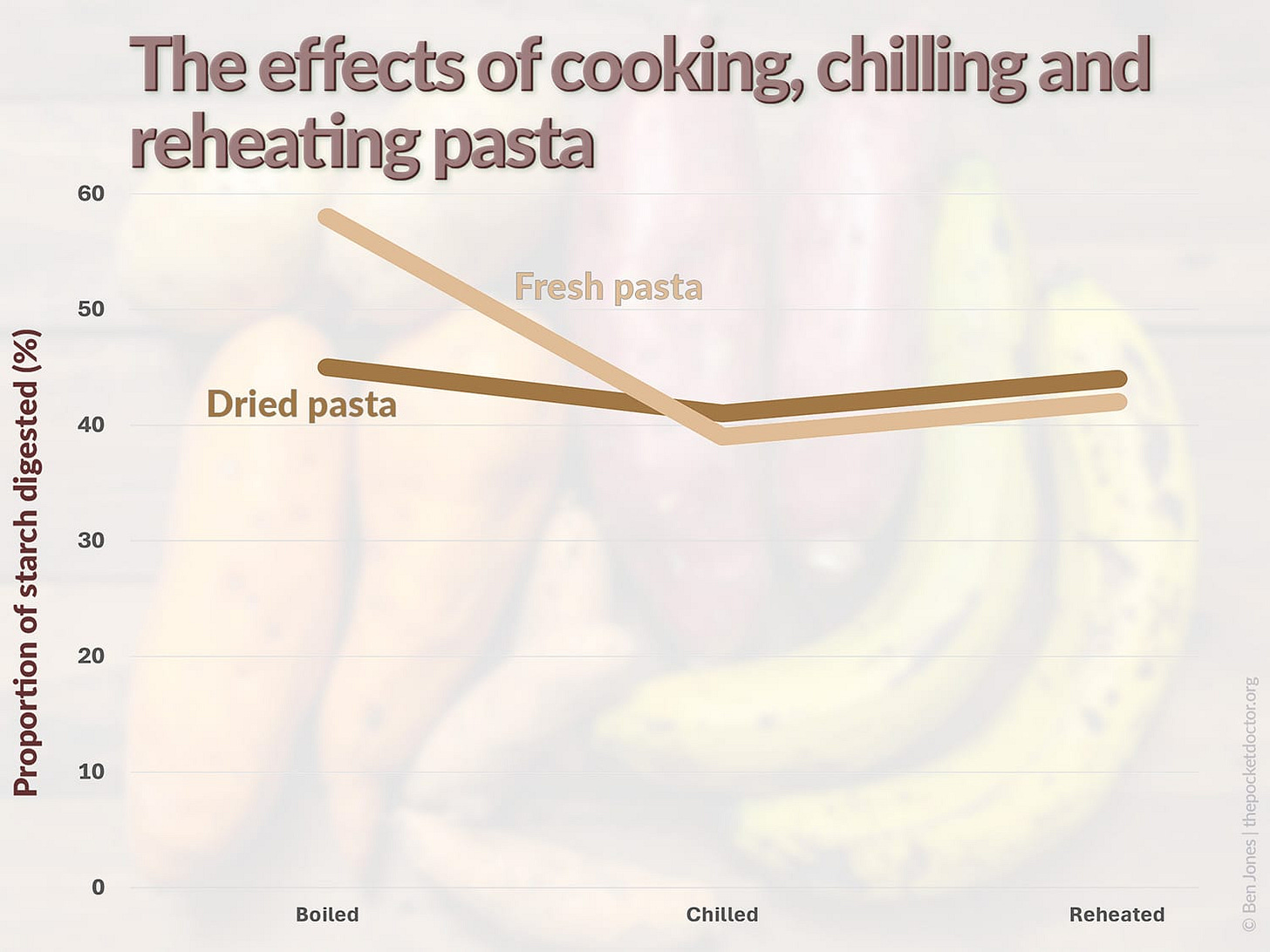The Gut-Friendly Carb Linked to Longer Life
Backed by large studies. Powered by humble foods. And probably missing from your diet.
The other night, I was staring at a cold potato, wondering if it was a superfood - (as one does!)
You’ve probably heard the trick: cook your pasta or potatoes, chill them overnight, and voilà - healthier carbs!
But you know what: the real power of resistant starch isn’t in clever fridge hacks. It’s in the foods that have had it all along - lentils, beans, and whole grains.
Unsexy? Possibly. Underrated? Absolutely.
In the revolving door of nutritional advice, carbohydrates have become the new public enemy.
Not long ago, it was fat. Low-fat yoghurts, low-fat everything - remember?
We blamed fat for everything. Now we’re pointing the finger at carbs.
And yet, the evidence tells a different story: people with the lowest risk of dying early tend to get 40–50% of their daily calories from carbohydrates.
Of course, not all carbs are created equal.
In the carbohydrate league table, fibre takes the top spot for its considerable health benefits.
Sugar languishes in last place for its waist-widening, diabetes-inducing tendencies.
And starch? Starch sits awkwardly in the middle - suspect, thanks to how easily it breaks down into sugar.
But here’s the thing: not all starch is equal either.
Some forms of starch might actually help lower cholesterol, steady blood sugar, reduce diabetes risk, and feed your gut bacteria in all the right ways.
And yes, there’s a bit of low-effort kitchen chemistry that can nudge things in the right direction, too.
Let’s take a look at resistant starch - what it is, where to find it, and why your gut will thank you.
Not All Starch Acts the Same
(Why some carbs behave more like fibre - and why that’s a good thing)
You might be surprised to hear that starch is simply lots of glucose molecules stuck together - a long chain known as a polymer.
It’s how plants store energy, which is why starch-rich foods - like potatoes, rice, wheat and cassava - are dietary staples all over the world.
Because we’ve relied on them for millennia, our bodies are very good at breaking starch down into glucose for quick energy.
(Incidentally, plants don’t just make glucose-based chains. Some use different sugars - like fructose or xylose - to build similar polymers. Our enzymes struggle with those. They pass through the gut undigested, and we call them dietary fibre.)
So when you eat a slice of white bread or a bowl of mashed potatoes, your digestive enzymes quickly break the starch down into glucose. That’s why you get a blood sugar spike.
It starts in your mouth - chew bread for a while, and you’ll notice it starts to taste sweet. That’s amylase in your saliva turning starch into sugar.
But not all starches play so nicely with your enzymes.
Some are built differently. Some are physically protected.
These are resistant starches - and they behave more like fibre.
There are several types, but three matter most when it comes to your diet:
1. Physically inaccessible starch
This is starch your enzymes can’t reach, because it’s locked behind cell walls or fibre.
You’ll find this in whole grains, seeds, and legumes (peas, beans, lentils). Your digestive system largely leaves it alone, and your gut microbes get first dibs.
2. Naturally resistant starch
In some foods, the starch molecules are packed tightly into crystals that enzymes can’t easily break down.
Examples? Unripe bananas, plantains, and raw potatoes (though please don’t eat those).
3. Retrograded starch
Here’s where the fridge trick comes in.
When you cook starchy foods in water (boiling potatoes, for example), the starch granules absorb water and swell. This process, called gelatinisation, makes them much easier to digest. That’s why boiled potatoes spike your blood sugar more than raw ones.
But… cool them down, and those gelatinised starches begin to form into tight crystals - much like the resistant starch in raw plantains or green bananas.
This process is called retrogradation, and it makes the starch more resistant to digestion.
Once they’re cooled, your body no longer breaks them down as easily into sugar. Instead, they make their way to your colon, where your gut bacteria feast - and that’s a good thing, as we’ll see.
Wellness blogs love this trick.
They’ll tell you that once starch retrogrades, it stays resistant - even if you reheat it. Meaning your leftovers are not only convenient, but better for you.
Is that actually true?
We'll find out!
Why Resistant Starch Deserves a Place on Your Plate
(And no, it’s not because you left your pasta in the fridge overnight.)
You’re probably thinking: this is all very interesting, but why does it matter?
Let’s start with one of the big reasons: staying alive.
In a study of more than 42,000 American adults tracked over ten years, those eating the most resistant starch were 15% less likely to die during the study than those eating the least.

That’s a big result.
Especially when you consider the study didn’t even account for retrograded starch - the kind you get from cooking and chilling pasta or potatoes. It was just looking at foods naturally high in resistant starch: lentils, beans, and whole grains.
The same study found a lower risk of cancer death in those eating the most resistant starch.

That doesn’t mean resistant starch alone is preventing cancer. It’s more likely that foods rich in resistant starch also contain other compounds that help protect the body - like polyphenols, fibre, and plant protein.
Either way, the message is the same: eat more of the foods that contain resistant starch, and you’re likely to benefit.
Blood sugar & cholesterol
Because resistant starch isn’t digested in the small intestine, it doesn’t turn into glucose the way normal starch does. So you avoid the post-meal blood sugar spike.
A meta-analysis of 15 studies found that resistant starch led to a modest reduction in fasting blood glucose.
The benefits were most pronounced at 28g/day or more (that’s a lot), or after 8+ weeks of regular intake - i.e. not just the occasional lentil salad.
And the effects were stronger in people with type 2 diabetes.
It’s a similar story with cholesterol.
Another meta-analysis found that consuming more resistant starch per day over time could lower LDL (bad) cholesterol by 2–3%.
These aren’t huge numbers, but they’re meaningful. And they’re likely additive over time, especially in combination with a generally healthy diet.
Feeding the gut bacteria that look after you
Many of the benefits of resistant starch have less to do with your bloodstream and more to do with your colon.
Because your body doesn’t break it down, resistant starch travels to your large intestine intact, where it becomes food for your gut bacteria - especially the beneficial kind.
That makes resistant starch a prebiotic: a type of food that feeds your microbiome and helps it thrive.
When gut bacteria ferment resistant starch, they produce short-chain fatty acids (SCFAs) - compounds with real, evidence-backed benefits. They:
Strengthen the gut barrier
Reduce inflammation
Improve blood sugar control
Lower LDL (bad) cholesterol
Help regulate appetite
Support brain function
Inhibit cancer growth (especially in the gut)
The more resistant starch you eat, the more SCFAs you produce - and the more diverse and resilient your microbiome becomes.
And that’s not just about digestion.
A healthy gut microbiome plays a key role in your immune function, metabolism, and even mood. It’s not a side character - it’s a central player.
Fridge Tricks vs. Food That Works
If you’re sold on the benefits of resistant starch, the next question is: how do you get more of it into your diet?
It all comes down to choosing the right carbs.
(And no, there’s no resistant starch hiding in your Oreos.)
The ideal carb has two things going for it:
High resistant starch content
Low glycaemic index (i.e. it doesn’t spike your blood sugar)
That sweet spot - bottom right on the chart - is where you want to aim:

And look who’s sitting there comfortably: lentils.
If you’ve never cooked with them, now’s a good time to start. They’re fast, forgiving, and a blank canvas for herbs and spices.
My go-to is a lentil dal with garlic, ginger, lemon and loads of garam masala - always better the next day.
(Pop your favourite lentil recipe in the comments if you’ve got a crowd-pleaser up your sleeve.)
Also pulling their weight: chickpeas, kidney beans, and yes - muesli.
Surprisingly, cornflakes contain a good amount of resistant starch, likely due to the type of engineered corn used. But with their sky-high glycaemic index, they’re not ideal.
And as the chart shows, there’s no neat line connecting resistant starch content and glycaemic index. That’s because other factors - like food structure, fat, and fibre - affect how fast a carb hits your bloodstream.
In other words, the magic isn’t just in the resistant starch - it’s in the foods that contain it.
Lentils, chickpeas, beans… the usual suspects.
What about the fridge trick?
Ah yes, the kitchen hack: cook your pasta or potatoes, chill them overnight, and suddenly they’re good for you.
The idea is this: cooling gelatinised starch causes it to “retrograde” - reforming into crystals that your enzymes can’t easily break down.
Some resistant starch does form. That part’s true.
One study found that chilling boiled or baked potatoes overnight increased their resistant starch by 24–70%, depending on the variety:

That's an extra two to four grams of resistant starch. Not bad considering most of us only get 5-6g a day.
If you reheat them, though, much of that resistant starch goes back to the regular sort - the line in the graphs heads back down again.
The upshot?
Eat your chilled potatoes cold (e.g. in a salad) for the best effect.
Baked beats boiled potatoes when it comes to resistant starch.
And pasta?
A lab study looked at fresh vs. dried pasta and found a bigger benefit from chilling the fresh stuff, not much to see with dried.
Reheating still preserved some resistant starch.

And rice?
One final study tested white rice eaten freshly cooked vs. chilled, then reheated.
No difference in blood sugar response.
Although interestingly, the reheated rice scored higher on taste.
The bottom line?
Yes, the fridge trick works a little - especially if you eat the carbs cold.
But if you’re hoping to transform your metabolic health one potato salad at a time, you’ll be disappointed.
The real win?
Lentils. Beans. Whole grains. Muesli. Foods that come with resistant starch built-in - and bring a lot more to the table than just retrograded starch.
I always make extra rice to save for the next day, so I was a bit disappointed to find it’s the one thing that doesn’t deliver much resistant starch.
And as a Brit who doesn’t care much for potatoes (I know, I know), it turns out lentils and muesli are doing more of the heavy lifting in my kitchen.
Cold pasta and potato salad is a nice bonus.
Chickpeas and lentils are the main event.
The Next Health Food Craze?
The growing buzz around resistant starch has Big Food licking its lips.
They know most people would rather eat a chocolate-coated "resistant fibre" bar than cook lentils - and industrial food science is happy to oblige.
There are already processes to convert potato or maize starch into synthetic resistant starch. It’s cheap, easy to sprinkle into a product, and great for front-of-pack claims.
So don’t be surprised when the supermarket shelves fill up with:
“Gut-friendly” snack bars
“Microbiome-boosting” cereals
“Cholesterol-lowering” pasta
All fortified with resistant starch.
And all ultra-processed.
Let’s not pretend that a powdered additive makes a cookie good for you. It’s still a cookie. And your gut bacteria don’t need it - they’d be happier with muesli.
So skip the fibre-fortified fairy dust and:
Add oats to your breakfast
Blend a slightly green banana into your smoothie
Dust off your best lentil recipe
No label claims. Just real food.
That’s where the good stuff lives.
Health Tweak of the Week
Most starches spike your blood sugar.
Some feed your gut bacteria, support metabolic health, and may even reduce your risk of cancer.
These are resistant starches - and this week’s tweak is to get more of them into your meals.
There are two reliable ways to do that:
1. Eat the foods that already contain it
Lentils, chickpeas, beans, muesli, whole grains - these aren’t just good sources of resistant starch. They’re also linked with lower cholesterol, better blood sugar control, and longer life in large studies.
Try:
A lentil-based soup, curry or salad
Swapping to whole-grain pasta or brown rice
Adding chickpeas or black beans to your salad or stir-fry
Starting the day with muesli or overnight oats
Adding a slice of rye toast to a meal
Blending half a greenish banana into a smoothie (Just not with berries - their antioxidants don’t play well with bananas’ enzymes)
2. Use the chill trick
If you’re boiling pasta or potatoes, make extra and refrigerate it overnight.
Enjoy it cold in a salad to get the most benefit.
Reheat gently if you prefer - some of the resistant starch will survive.
It's not kitchen magic - but it's not nothing either.
This week: swap one easy-to-digest starch for a more resistant one.
Your healthy gut bacteria will thank you - by making chemicals that lower inflammation, improve metabolism, and even protect your brain.
You're not just eating better carbs. You're feeding the bacteria that help run your immune system, calm inflammation, and influence your health from the inside out.
🎧 If you’d rather listen while your pasta chills…
🎙️ This week’s episode of One Health Tweak a Week Podcast goes deep on resistant starch:
Why some carbs spike your blood sugar - and others don’t
The humble foods that feed your microbiome
What wellness blogs get wrong about cold pasta
👉 Listen now while your leftovers cool
(Psst: these episodes are free for now, but won’t be forever. Paid subscribers help keep this newsletter going - and get bonus content, private member chat and insider Q&As.)
👉 What’s next?
💬 Got a favourite lentil, bean, or whole-grain recipe? Drop it in the comments - your fellow readers will thank you.
📢 Know someone still afraid of carbs? Forward this to them. They need lentils more than another low-carb snack bar.
❓ Seen a new “gut-friendly” food with big promises? Hit reply - we’re keeping tabs on the fibre-fortified arms race.
🔒 Want smarter tweaks every Saturday? - Upgrade to a paid subscription for bonus content, private member chat, Q&As, and the satisfaction of supporting responsible, evidence-based wellness writing.
🌟 Already a premium member? - Come and find me in chat.
Until next time - stay curious, stay grounded, and maybe cook a little extra for the fridge.
– Ben






Ben, this is a fantastic and brilliantly articulated breakdown of a topic that is often butchered by wellness blogs. As a fellow biochemist, I especially appreciate the clear distinction between the minor metabolic win from retrogradation and the major win from whole-food sources like legumes.
The point about SCFAs (especially butyrate) is the critical takeaway here. So many people chase the "fridge hack" without realizing the real magic is in consistently feeding the microbiome the prebiotic fiber it needs to produce those powerhouse signaling molecules.
Your chart visualizing the Glycemic Index vs. Resistant Starch content is superb...a perfect tool for illustrating that the food matrix is everything. Excellent work.
Okay I’m going to try lentils. I think I had a bad experience with them many years ago. They were bland, probably overcooked and certainly unappealing. Going to try again. By the way, what comprises a good Muesli?